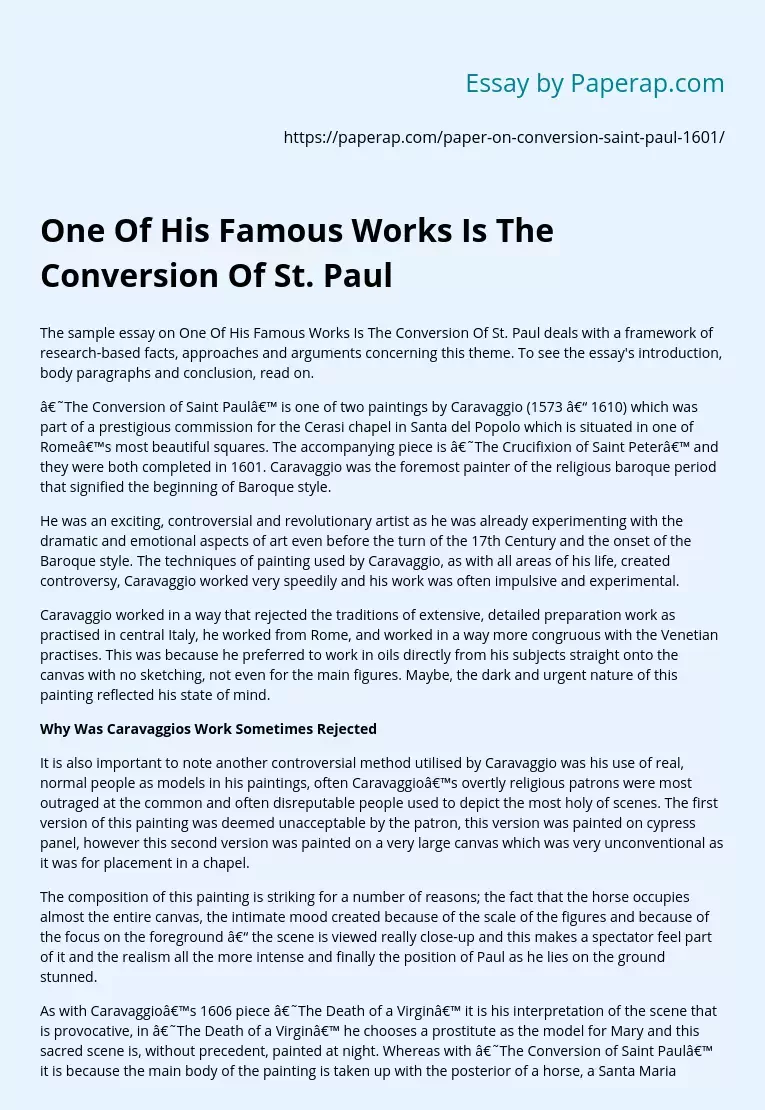One Of His Famous Works Is The Conversion Of St. Paul
The sample essay on One Of His Famous Works Is The Conversion Of St. Paul deals with a framework of research-based facts, approaches and arguments concerning this theme. To see the essay’s introduction, body paragraphs and conclusion, read on.
‘The Conversion of Saint Paul’ is one of two paintings by Caravaggio (1573 – 1610) which was part of a prestigious commission for the Cerasi chapel in Santa del Popolo which is situated in one of Rome’s most beautiful squares. The accompanying piece is ‘The Crucifixion of Saint Peter’ and they were both completed in 1601.
Caravaggio was the foremost painter of the religious baroque period that signified the beginning of Baroque style.
He was an exciting, controversial and revolutionary artist as he was already experimenting with the dramatic and emotional aspects of art even before the turn of the 17th Century and the onset of the Baroque style. The techniques of painting used by Caravaggio, as with all areas of his life, created controversy, Caravaggio worked very speedily and his work was often impulsive and experimental.
Caravaggio worked in a way that rejected the traditions of extensive, detailed preparation work as practised in central Italy, he worked from Rome, and worked in a way more congruous with the Venetian practises. This was because he preferred to work in oils directly from his subjects straight onto the canvas with no sketching, not even for the main figures. Maybe, the dark and urgent nature of this painting reflected his state of mind.
Why Was Caravaggios Work Sometimes Rejected
It is also important to note another controversial method utilised by Caravaggio was his use of real, normal people as models in his paintings, often Caravaggio’s overtly religious patrons were most outraged at the common and often disreputable people used to depict the most holy of scenes.
The first version of this painting was deemed unacceptable by the patron, this version was painted on cypress panel, however this second version was painted on a very large canvas which was very unconventional as it was for placement in a chapel.
The composition of this painting is striking for a number of reasons; the fact that the horse occupies almost the entire canvas, the intimate mood created because of the scale of the figures and because of the focus on the foreground – the scene is viewed really close-up and this makes a spectator feel part of it and the realism all the more intense and finally the position of Paul as he lies on the ground stunned.
As with Caravaggio’s 1606 piece ‘The Death of a Virgin’ it is his interpretation of the scene that is provocative, in ‘The Death of a Virgin’ he chooses a prostitute as the model for Mary and this sacred scene is, without precedent, painted at night. Whereas with ‘The Conversion of Saint Paul’ it is because the main body of the painting is taken up with the posterior of a horse, a Santa Maria cleric noted this conversation between Caravaggio and one of his critics: “Why have you put a horse in the middle, and St. Paul on the ground? ” “Because! ” “Is the horse God? ”
“No, but he stands in God’s light” Page 66 ‘Caravaggio’ by Giles Lambert) The way this painting is arranged means that the drama is very internal to Paul, the way his eyes are closed as if he has been blinded by the light of God that pours across the picture, highlighting certain sections of Paul’s anatomy and that of the cumbersome horse. Paul does not have a halo, so it is up to the viewer, believer or atheist, the decided whether this light is holy. Whilst Caravaggio clearly selected the most dramatic scene possible given his conventional and very popular subject matter he still portrays it with immense naturalism.
It is perhaps because of his use of real people as models, people he saw in the street that the painting conveys a realism that is not mundane but made theatrical by the dramatic use of chiaroscuro and the powerful foreshortening of Paul as he lies on the ground that create a sense of heightened emotion. The realistic depiction of Paul, his arms outstretched, is as if he truly has just been blinded and thrown off his horse, it is like he has just that moment been struck down.
The position of Paul, the angle from which we view his head and the angle at which his body extends into the depth means that spectator needs to turn their own head to try and look at the Paul’s eyes. The raised arms create a kind of frame drawing the eye along the recessive diagonal of the body right into the centre of the picture. The colours used in the painting are earthy tones, in the background, muted and dark, and in the foreground more vivid with the red cloth underneath Paul and the oranges of his armour.
This means that whilst Paul, the focal point of the painting, is in an unconventional position on the ground he is still obviously important and stands out significantly more than the groom, who is hardly noticeable emerging from the shadows in the top right corner. In addition there are stylistic touches typical of 17th Century artists, such as the masterful effect of texture shown in the discarded Roman helmet in the bottom right-hand corner, the metal truly looks metallic with the touches of reflective light shimmering, in contrast to the soft feathers painted with equal attention to create a completely contrasting texture.
Caravaggio’s work is often described as a violent reaction to the constrained and academic style of the Mannerists, Caravaggio was revolutionary in creating an intense realism that would have a great influence on later artists. Caravaggio aimed to move his work and art itself forward by abandoning the idealisation of human and religious subjects. Also he focused equally on human figures and inanimate objects – still life. This can be seen in the detailed rendering of the helmet and sword but Caravaggio’s skill at still life is demonstrated more fully in works such as ‘Supper at Emmaus’ (1601) and ‘Basket of Fruit’ (1598).
With his ‘theatrical realism’ it could be assumed that Caravaggio was severing links entirely with the artists of the Renaissance however this is not completely true as he did borrow from the antiquity of Michealangelo and Rapheal, he was most clearly trying to emerge from the instability of the Mannerist era, as Giotto emerged from Byzantinism. During the 17th Century artists became interested in light and movement, however Caravaggio was most interested in light, or perhaps, conversely, most interested in shade.
In the Renaissance artists used the effect of overall light to define the human figure, for them, shade was there to accentuate light. But Caravaggio, sometimes referred to as ‘The Master of Darkness’, began with shade. He made his figures emerge, dramatically from the shadows using linear strokes of light. This had the effect of making muscles and the sheer volume of the figures stand out in their own space. This, whilst different to the Renaissance approach, was the complete opposite to the Mannerist one.
Mannerism, which took Renaissance traditions to the extreme, practically eliminated any contrast between light and shadow making pale, ghostly figures. However, whereas other artists such as Poussin (a great enemy of Caravaggio) Carracci and Rubens where exploring the exciting, intricacies of creating a real sense of movement Caravaggio abstained. Instead he developed a feature of his art that his contempories could not understand which was, representing significant moments of stillness this allowed him to truly penetrate the psychological elements of a scene. ‘Conversion of Saint Paul’ (1530) or from Parmigianino’s version of this scene.
In addition to Caravaggio using sources such as these, his work inspired many artists after his time, it has been demonstrated that Caravaggio’s ‘The Conversion of Saint Paul’ inspired artist Georges de La Tour’s ‘Saint Joseph as a Carpenter’. In creating this painting it can be said that Caravaggio did keep close to the actual Bible story as far as the details of events are depicted, but what was revolutionary was his goal to make an extraordinary biblical event look ordinary, it was this quest to depict the truth that meant he was largely critically condemned.
This piece is a good example of Caravaggio’s pessimistic realism, his dark and gloomy impression of human nature and destiny. It was this truthfulness, this examination of the dramatic relationships of life, death and grief that opened a door for later 17th Century artists to explore emotive realism. Throughout his life, Caravaggio had a number of powerful, wealthy patrons, they had to possess some authority as it was often necessary for Caravaggio to have to be extracted from prison. This Santa Maria del Populo commission came on the back of his equally famous commission for the Contorelli Chapel of San Luigi dei Francesi.
The Cerasi Family had bought the chapel as the family funeral chapel and in the autumn of 1600 Tibero Cerasi, Treasurer General to Pope Clement VIII commissioned both Caravaggio and Annibale Carracci to decorate the chapel. The first versions of the two paintings Caravaggio submitted were rejected by Cerasi’s heirs, on the grounds of their violence and bright colours. The second versions were well accepted by the patrons and installed in the chapel, where they remain to this day, along with Carracci’s ‘Assumption of the Virgin’.
Only the first version of ‘The Conversion of Saint Paul’ survived and is in the Odescalchi-Balbi collection. Caravaggio was working in a climate of great religious, political and social unrest in Italy, as a reaction to the Reformation and the minimalism of the Protestant faith came the Counter – Reformation. This was a period of time when the Catholic Church reasserted it’s power where it could, and Religious Baroque is a style that was forced upon artists by Catholic authorities.
This was a time of militant Catholicism, there was a crusade of censorship, indoctrination including the use of propaganda, it was almost impossible for an artist to paint something other than a religious scene. Although Caravaggio was very much a natural rebel and a bohemian, the effects of the Counter – Reformation can be clearly seen through the big commissions of his life, such as the Cerasi and Contarelli commissions. These are typical of the type of art the Catholic Church demanded, art that involved viewers emotionally so they could take part in the religious experience themselves.
The Conversion of Saint Paul’ and ‘The Crucifixion of Saint Peter’ are archetypal because of their large scale depiction’s of the suffering of saints and matydom. To enforce the censorship of subjects disapproved by the Catholic Church financial support of artists working outside the catholic church was scarce. It was because the Protestants criticised Catholicism for being too lavish in regards to art that so many elaborate works of great size were commissioned during this period, works such as this.
One Of His Famous Works Is The Conversion Of St. Paul. (2019, Dec 07). Retrieved from https://paperap.com/paper-on-conversion-saint-paul-1601/

